- A brief history of Kathmandu, Nepal
- Kathmandu Location: Where is Kathmandu Located?
- The natural topography of Kathmandu
- Arts and Architecture of Kathmandu
- UNESCO World Heritage Sites of Kathmandu
- Kathmandu Airport - Tribhuvan International Airport
- The weather in Kathmandu
- Kathmandu Temperature in all Seasons
- How does the author describe kathmandu busiest streets?
- Final Words
Kathmandu, the Himalayan kingdom’s epicenter, is famous for its mixture of historical landmarks and monuments. The city’s highlights are its temples and impressive architectural monuments and landmarks, which profoundly dot every corner and nooks of the city. It sits at the height of 1400 meters and has a bowl shape- with mountains in its edges. Because of this beautiful formation, Kathmandu was traditionally known as “Nepal Proper,” filled with various exciting and unique cultures. Visitors sightseeing the Kathmandu city can experience diverse cultures coming from different parts of the country. Not to forget the old to modern traditions the city is jostling with modern technology. Thus, with a tour of the city, travelers are sure to have a fantastic experience.
Moreover, Kathmandu is a contemporary city that adorns impressive architecture and culturally rich heritage sites from ancient times.
The city of Kathmandu is a continually developing metropolitan nestled in the foothills of the Himalayas. The valley was once ruled by various royal dynasties. Thus, the town preserves the palaces as memorabilia of the royal families of the different periods. Similarly, Kathmandu valley houses many monarchical and historic structures on the UNESCO list of world heritage sites. Thus, the city not only offers historical insight but is also a sanctuary for spiritual travelers. With countless temples hiding in the corners of the city, the city reverberates a solid spiritual ambiance.
A brief history of Kathmandu, Nepal
When looking into the history of Kathmandu, several mythological facts about the valley pop up on the internet. Kathmandu’s cultural and heritage past sounds epic, with countless momentous events and revolutionary reforms. From the time the valley was discovered, the land has been ruled by several rulers and invaders. The city ground displays immense structures, temples, inscriptions, statues, and other artifacts that reflect Kathmandu’s growth over time. These structures harken back to Kathmandu’s illustrious past.
The history of Nepal is categorically put in three different periods: ancient, modern, and current. The study done by archaeologist’s excavations points that Kathmandu was discovered from 167 BC to 1 AD. On the same note, as per the myths, there are various notions regarding the origin of Kathmandu. Nevertheless, the most profound is the Swayambhu Purana. Legends suggest that the city was originally a Nagdaha, a deep lake, according to the Swayambhu Purana. Manjushree is said to have created Kathmandu by draining the Lake. Later, when experts researched Kathmandu, they discovered that the valley was submerged.
Various dynasties of kings and monarchs have ruled the area throughout history. Of all the eras, the Licchavi holds the greatest credit for contemporary Kathmandu. Inscriptions, sculptures, and carving are some of the Licchavi period’s contributions. It was around this time, architectural wonders thrived in the country. Alongside architectural progress, the state also saw an economic boost making the Licchavi period the golden age of Nepal. The arrival of Newars and the formation of Buddhist monasteries were also noted in this era. Newars were quite well-known figures throughout Asia because of their artistic talents. Similarly, it was in this period, Nepal successfully built a trading relationship with India and Tibet.
After the incredible period of the Licchavi era came the Malla period in Nepal. The Kathmandu Valley was split into 4 fortified cities during the Malla era: Kantipur, Lalitpur, Bhaktapur, and Kirtipur. These were the capitals of the Nepalese Malla confederation. These states competed in the arts, architecture, and trade, which resulted in enormous growth. Since these cities were constantly in competition regarding arts and architecture, there is direct or indirect involvement of then rulers in constructing these historical landmarks. This era perceived public structures, squares, temples, waterspouts, guthis, legal systematization, plays, and performances. Additionally, Kathmandu Durbar Square, Bhaktapur Durbar Square, Patan Durbar Square, Krishna temples, and other notable architectural structures of the Malla period.
Kathmandu Location: Where is Kathmandu Located?
Kathmandu is the capital and largest city of Nepal, located in the heart of the Kathmandu Valley in central Nepal. It sits in Bagmati Province and stands at an elevation of about 4,600 feet (1,400 meters) above sea level. The city is surrounded by a ring of green hills and mountains like Shivapuri, Phulchoki, Nagarjun, and Chandragiri, which gives the valley a bowl-like shape and adds to its natural beauty.
Geographical Location of Kathmandu
In terms of location, Kathmandu lies between 27°27′ to 27°49′ North latitude and 85°10′ to 85°32′ East longitude. It’s bordered by Bhaktapur and Kavrepalanchok districts to the east, Dhading and Nuwakot to the west, Nuwakot and Sindhupalchok to the north, and Lalitpur and Makwanpur to the south.
As Nepal’s cultural and economic center, Kathmandu is a vibrant mix of ancient history and modern life. From centuries-old temples to bustling markets, the city is both a starting point for Himalayan adventures and a fascinating destination in its own right.
Kathmandu is not in India — it is in Nepal.
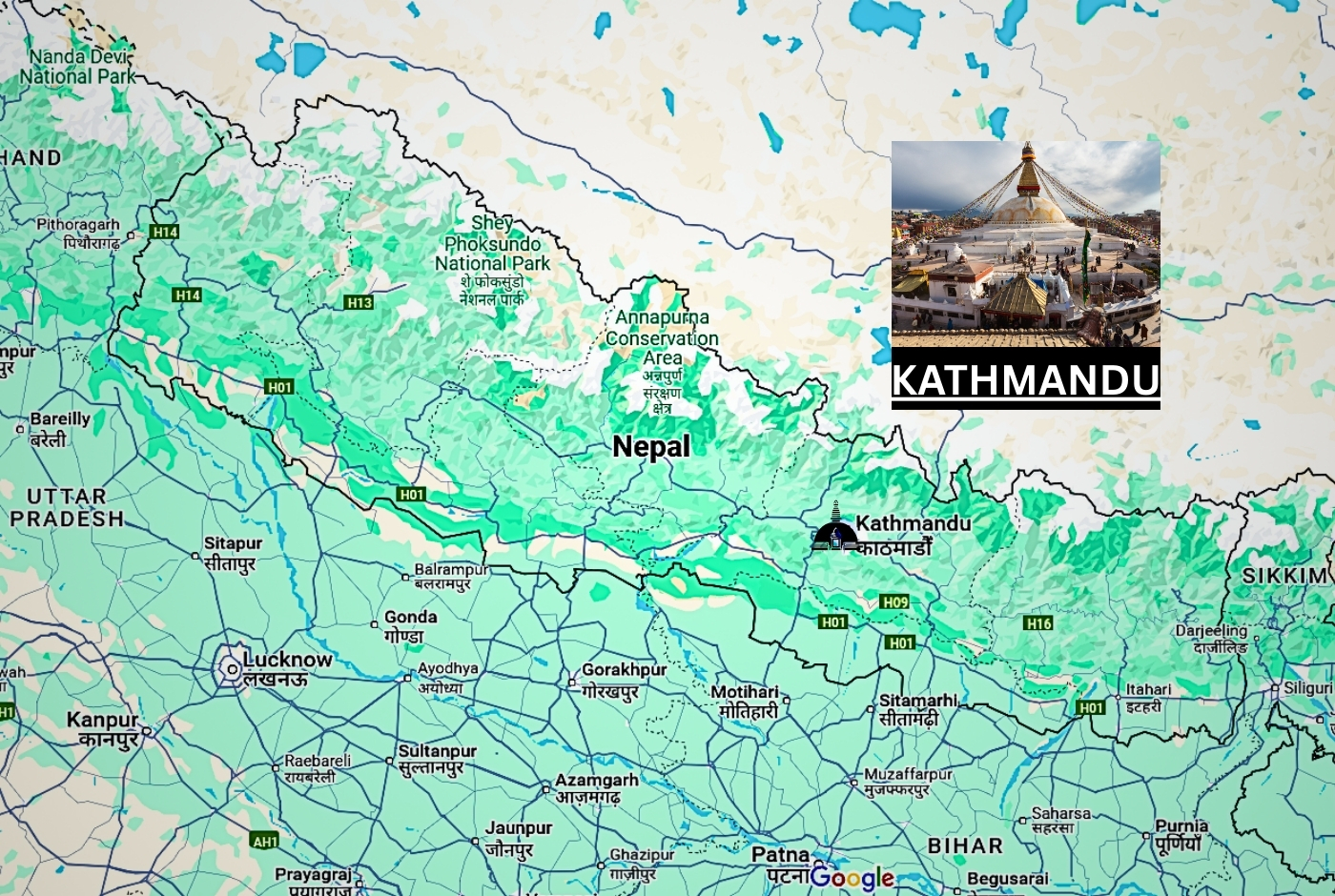
Elevation of Kathmandu | What is Kathmandu's height?
Kathmandu's elevation is approximately 1,324 meters (4,344 feet) above sea level. This makes it the capital of Nepal, located in the heart of the Kathmandu Valley. The city is situated in a bowl-shaped valley surrounded by mountains.
The natural topography of Kathmandu
Kathmandu is roughly oval, with a maximum width of 19 kilometers and 25 kilometers along its east-west axis. It is located in the lower Himalayas of central Nepal, surrounded by huge mountains. In its north is the famous hiking spot Shivapuri, and its east is Nagarkot- a popular hill station to view sunrise and sunset amidst the massive Himalayas of Nepal. Phulchowki Hill Station is in the south, and Chandragiri Ridge in the west are surrounding hills with over 2000 meters. Kathmandu has a subtropical, continental, and semi-humid climate. Thus, due to its diverse climatic zones, Kathmandu has one of Nepal’s beautiful climates.
Arts and Architecture of Kathmandu
Kathmandu has a thriving art scene. It exemplifies a mix of traditionalism and modern art, influenced by a wide range of national, Asian, and international influences. The valley is often referred to as “a vast treasure trove of art and sculptures.” The valley’s architectural integrity is profound because of its incredible monuments and landmarks. The city thrives with temples, shrines, stupas, Gompas, chaityas, and palaces made of wood, stone, metal, and terracotta. Kathmandu is Nepal’s cultural capital, with galleries showcasing current artisans’ work and ancient art collections.
As the heart of Nepal’s history, art, culture, and economy, Kathmandu is teeming with multiethnic residents, most of whom practice Hinduism and Buddhism. Religious and cultural festivals play an essential role in the life of Kathmandu residents. Furthermore, Kathmandu has a strong hand in tourism because the valley serves as a gateway to the Nepalese Himalayas. The disastrous earthquake of 2015 ruined most historical landmarks of the city. But, they were able to retain their former glory after years of rehabilitation and restoration work in the heritage sites.
UNESCO World Heritage Sites of Kathmandu
The old trade route that went through Kathmandu between India and Tibet allowed merging creative and architectural traditions from various countries with local art and architecture. In addition, Hindu and Buddhist religious traditions have affected Kathmandu City’s monuments over the years. In 2006, UNESCO designated seven historical landmarks in and around Kathmandu as World Heritage Sites. The following is a list of UNESCO World Heritage Sites in Kathmandu city:
Pashupatinath Temple of Kathmandu
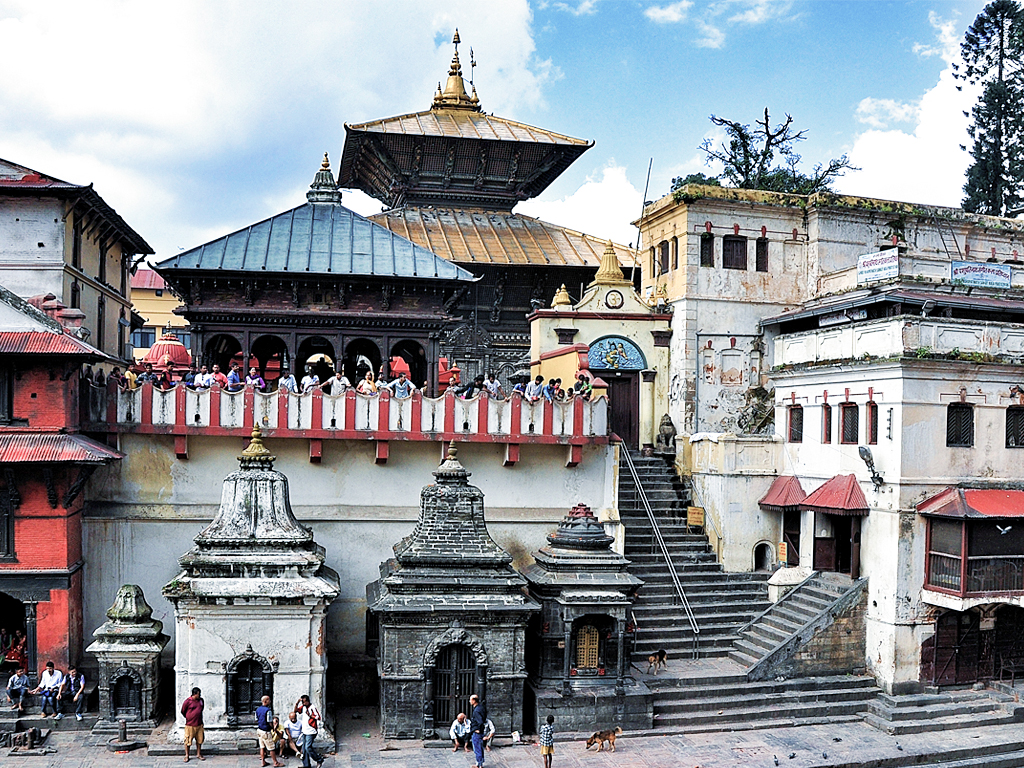
Pashupatinath is one of the most prominent Hindu God Shiva sanctuaries, located on the banks of the sacred Bagmati River. During the famous Hindu holidays, the temple attracts thousands of worshipers from Nepal and India. Various minor and significant temples decorate the holy place and welcome throngs of tourists every day. Aryaghat of Pashupatinath is another attraction that is quite soulful to observe. Tourists visit Pashupatinath to witness cremations at Aryaghat, where Nepali people perform funeral rites for the deceased. Sadhus, Shiva’s disciples, are also a popular tourist attraction of Pashupatinath temple. Their unique appearance attracts tourist’s interest a lot.
Kathmandu Durbar Square
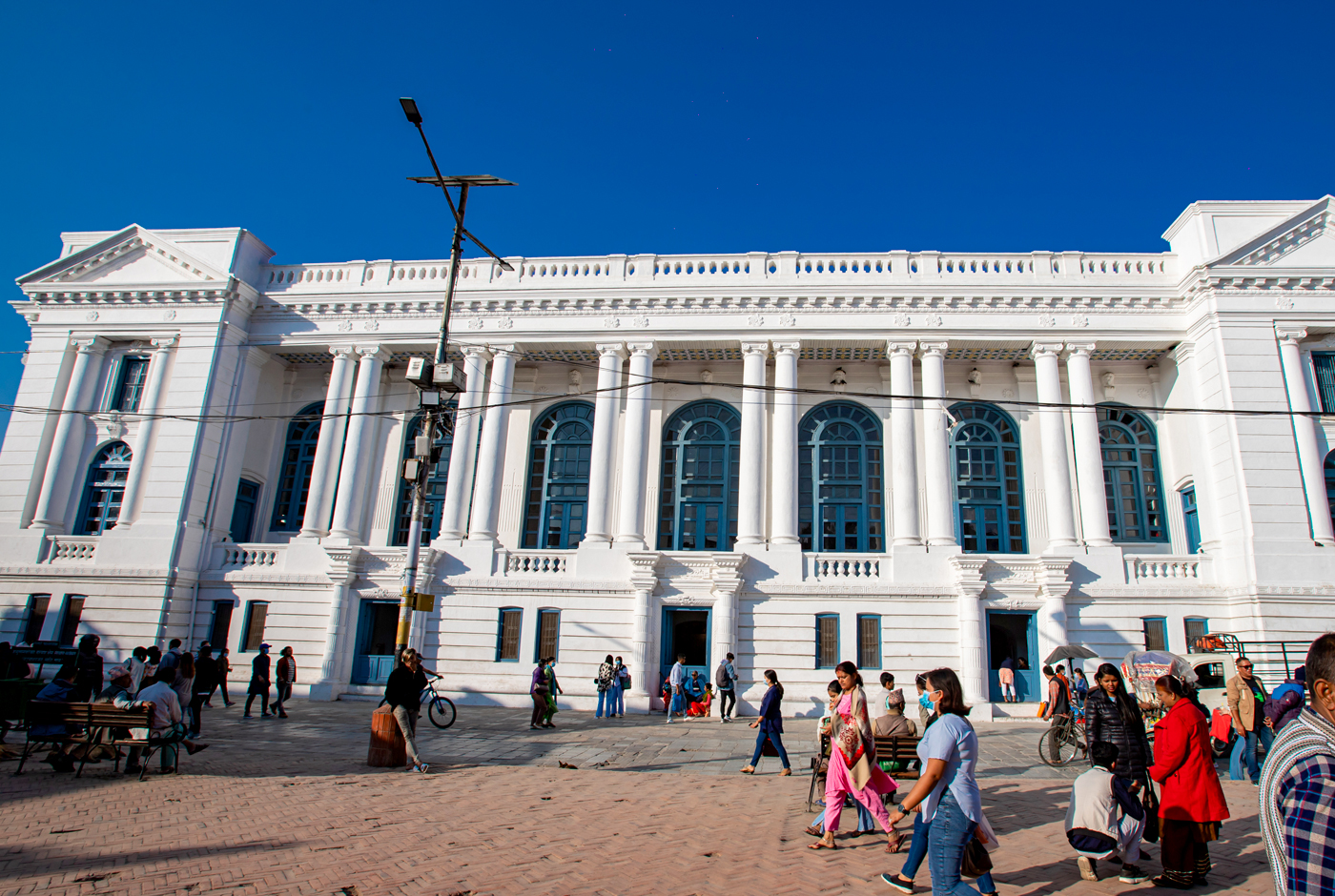
The historic and iconic Kathmandu Durbar Square is one of three UNESCO World Heritage Sites in Kathmandu. The precise translation of the term “Durbar Square” is “Place of Palaces.” In the palace complex, there are two quadrangles of the Durbar Square and has 50 temples. The Kasthamandap, Kumari Ghar, and Shiva-Parvati Temple are located in the outer quadrangle, while the Hanuman Dhoka Palace is located in the inner courtyard. Around the palace area, visitors can observe the centuries-old artworks and craftsmanship of Newar artisans. At the entrance of Durbar Square, there is a giant statue of Lord Hanuman, a monkey devotee of Lord Ram. The figure has a tremendous influence on locals. Thus, many call the Kathmandu Durbar Square Hanuman Dhokha as well.
Boudhanath Stupa

A sacred site for Buddhist pilgrims, Boudhanath is one of the largest stupas in the world. House stores, cafes, restaurants, and motels completely encircle the pilgrimage site. There are a few monasteries near Bouddhanath stupa, where they teach Buddha’s wisdom to young monks. Also, people circumambulate the stupa chanting Buddhist mantras at all hours of the day, which is quite a nice scene to witness. Similarly, youths gather to spend quality time with their friends. Overall, it is a perfect place in Nepal to observe locals residing in Kathmandu.
Swayambhunath
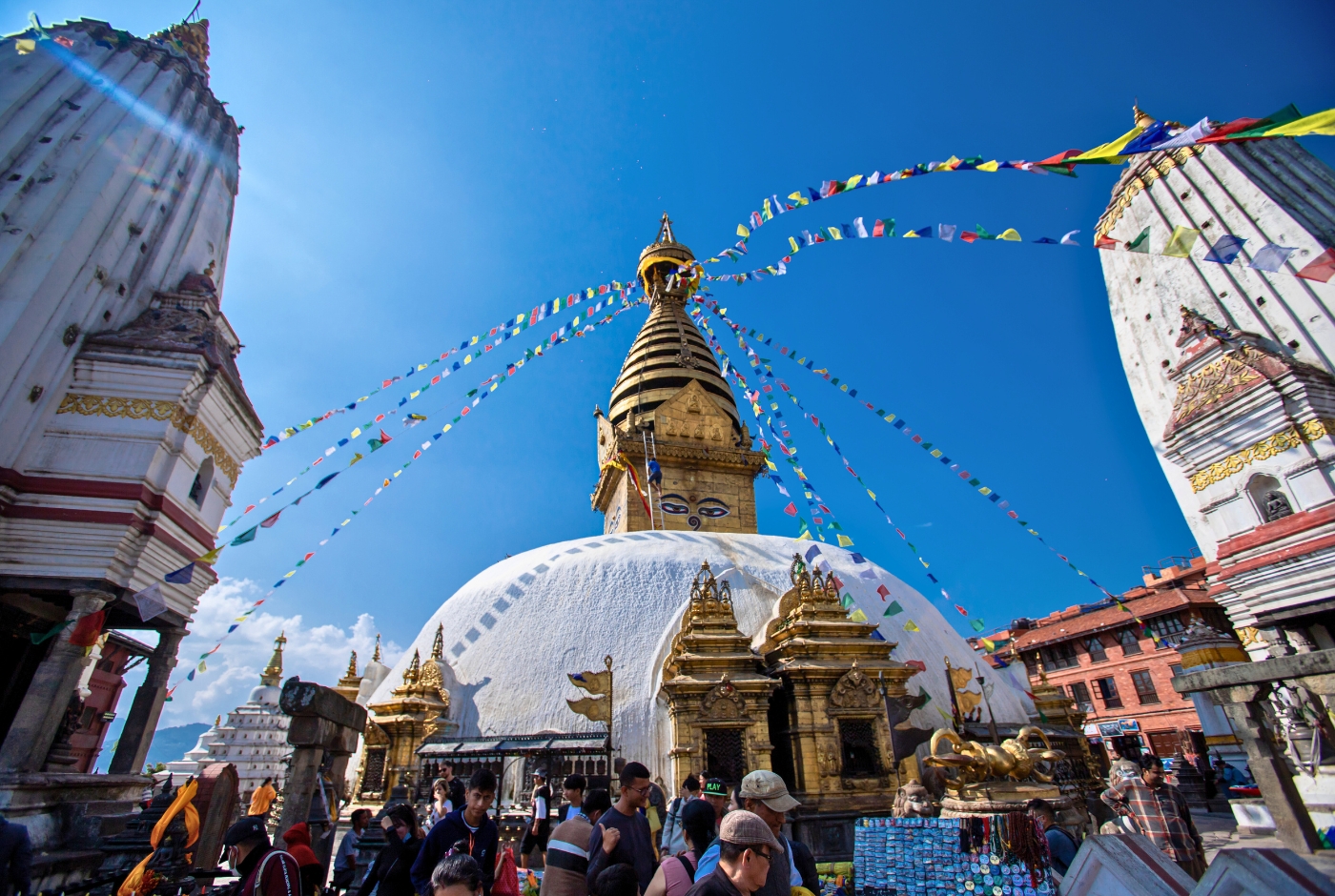
Swoyambhunath, located on a mountaintop west of Kathmandu, is one of Nepal’s oldest stupas. Local devotees assemble every morning for puja and circumambulation. This is quite an exciting sight to observe for visitors. The hilltop offers a panoramic view of Kathmandu, and a trip to the Manjushree Chaityas on the next hill is worthwhile. The stupa complex is home to swarms of rhesus monkeys, earning it the nickname “Monkey Temple” by early visitors. For both Newar and Tibetan Buddhists, Swoyambhu is one of the most prominent Buddhist pilgrimage places. If you’re in the vicinity, the Natural History Museum on the outskirt of the stupa is well worth a visit.
Kathmandu Airport - Tribhuvan International Airport
Tribhuvan International Airport (KTM/VNKT) is the primary gateway into Nepal, located just 5.56 kilometers east of Kathmandu’s city center. As the country’s only international airport, it plays a vital role in connecting Nepal to the rest of the world, while also serving as a central hub for domestic air travel across the Himalayan region.
The airport features two terminals: one dedicated to international flights and the other to domestic flights. Despite its modest size compared to major global airports, Tribhuvan handles a significant volume of traffic and remains the busiest airport in Nepal.
Tribhuvan International has a single runway measuring 3,350 meters (10,958 feet) in length, which accommodates a range of aircraft, including long-haul international flights. It serves as the main base for Nepal Airlines, Himalaya Airlines, and several other domestic carriers that provide essential air links to remote regions across the country.
From KTM, travelers can reach over 40 international destinations in 17 countries, including India, China, countries in the Middle East, Southeast Asia, and even select locations in Europe. On the domestic front, the airport offers regular flights to all major cities and airstrips throughout Nepal, making it an indispensable part of the nation's transportation network.
While the airport continues to face challenges with capacity and infrastructure, it remains the critical aviation hub for millions entering and leaving Nepal each year.
How to Reach Kathmandu from India?
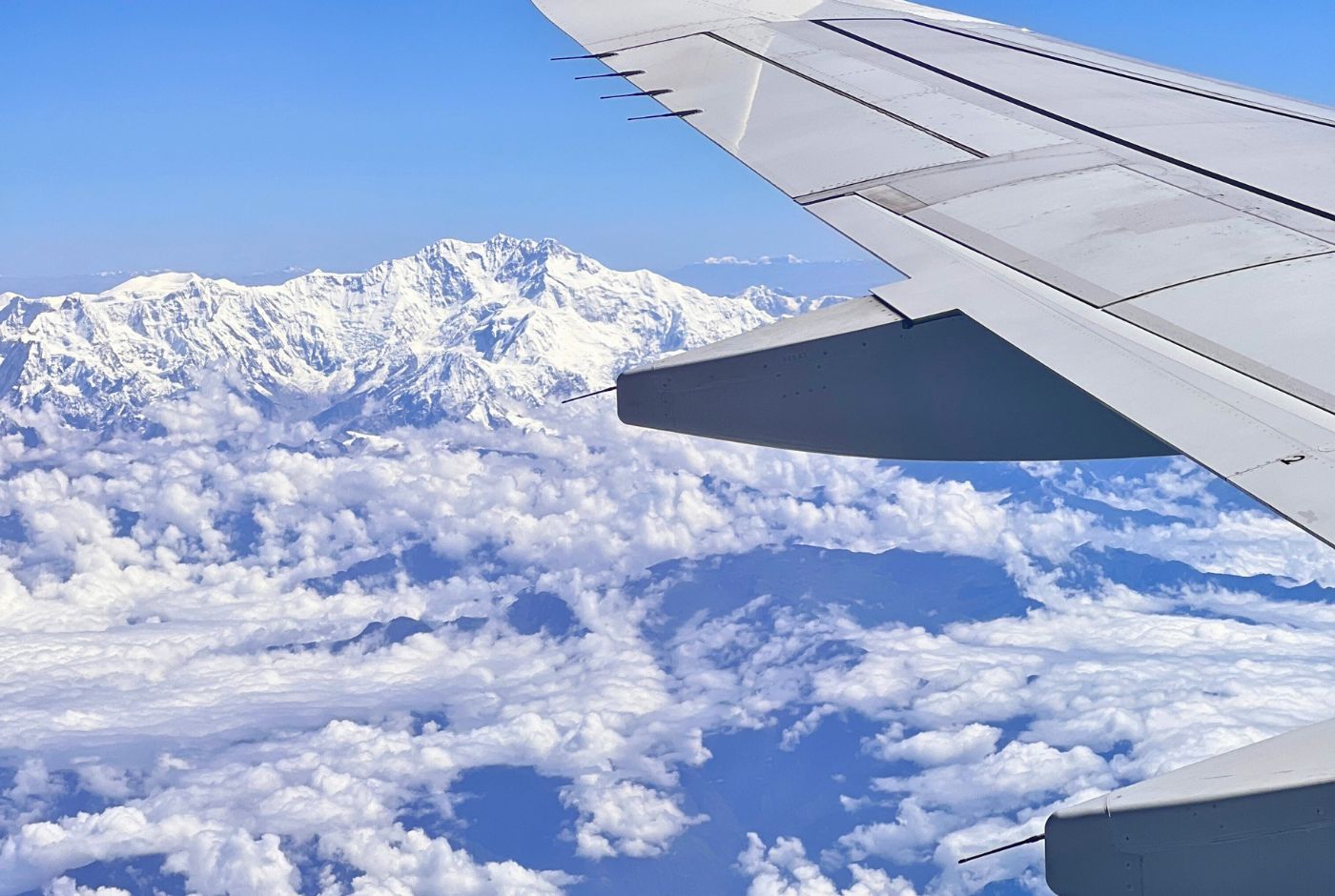
If you're planning to travel from India to Kathmandu, you've got a few solid options—by air, by bus, or by mixing train and bus. Each has its own vibe, depending on your budget, time, and how adventurous you're feeling.
By Air: The quickest way, hands down, is to hop on a flight. IndiGo runs daily non-stop flights from Delhi to Kathmandu, and according to them, they’re the only airline offering that direct route at the moment. The flight's short and sweet, and you’ll land at Tribhuvan International Airport (KTM)—Nepal’s only international airport, just a stone’s throw from central Kathmandu. If you're short on time or not up for a long road trip, flying's the way to go.
By Bus: Now, if you're rolling on a budget or want to soak in the journey, the bus route’s a solid pick. There’s a direct bus service from New Delhi to Kathmandu, and it runs regularly, as per the Delhi Transport Corporation. It’s definitely longer, but it’s more scenic, and you get to see a slice of rural life along the way.
By Train and Bus Combo: This one’s for the more adventurous traveler or someone who likes piecing the journey together. You can take a train from Delhi to Gorakhpur, which takes around 14 hours. From Gorakhpur, hop on a bus or jeep to the Sunauli border—that ride’s just a few hours. Once you cross into Nepal (which is super chill for Indian citizens), it’s a short walk to Bhairahawa’s bus station. From there, buses to Kathmandu run regularly.
Quick Recap:
- Flight: Fastest option, direct from Delhi to Kathmandu.
- Direct Bus: Slower but budget-friendly and more scenic.
- Train + Bus: Great if you like to break up the journey and don’t mind a bit of bouncing around.
Whichever way you roll, the journey from India to Kathmandu can be part of the adventure itself. Just be sure to check bus and train schedules ahead of time, especially during holidays or peak seasons.
How to reach Kathmandu from America, Australia, and other countries?
If you're flying to Kathmandu from countries like the U.S. or Australia, expect at least one layover—there are currently no direct flights from these regions. Most travelers connect through major hubs in the Middle East or Asia, with Dubai, Doha, and Istanbul being the most common stopovers. Once you land, you'll arrive at Tribhuvan International Airport (KTM), Nepal’s main international gateway.
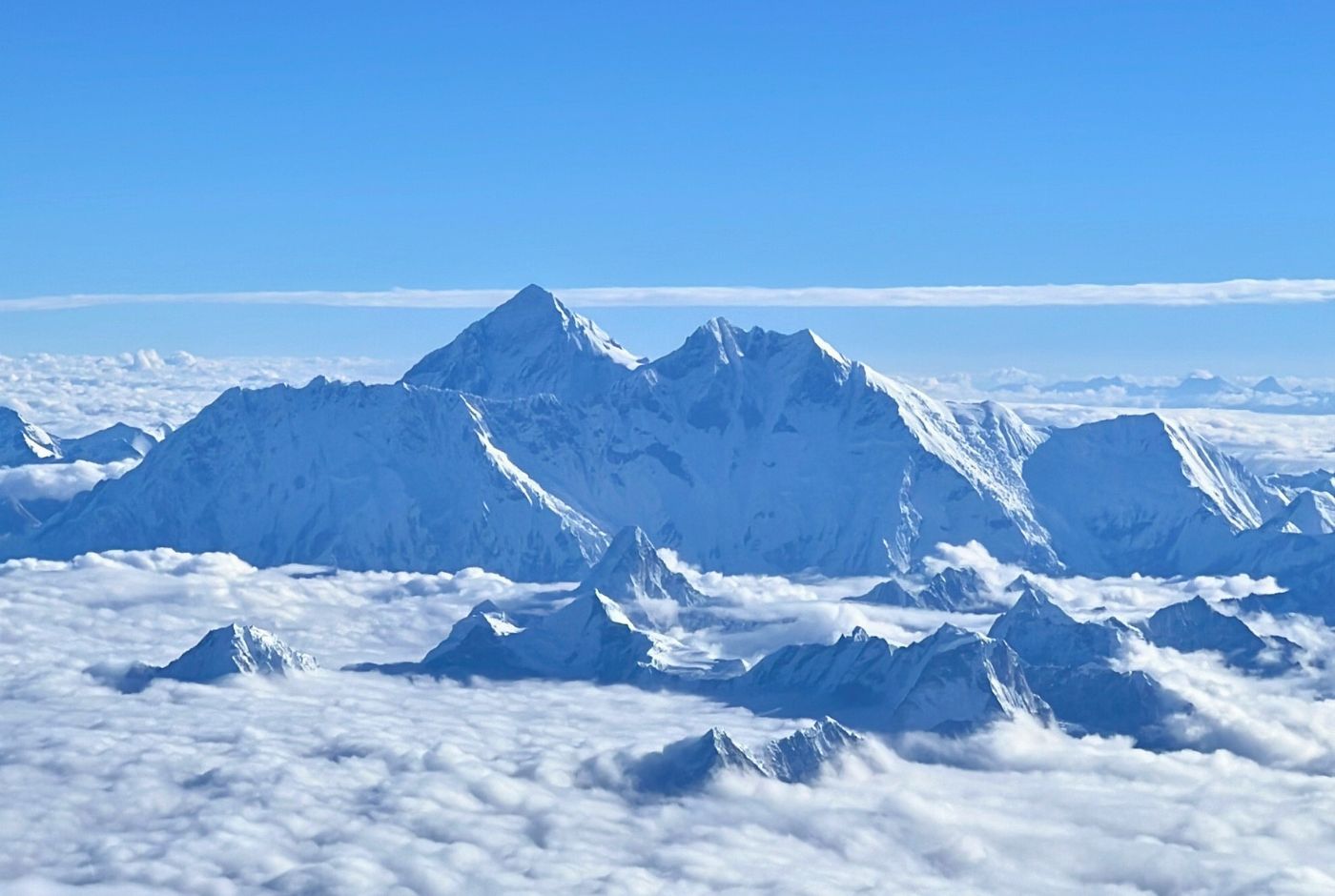
Step-by-Step: Getting to Kathmandu
1. Book Your Flight: Start by searching for flights to Kathmandu (KTM) from your home city. Since direct flights aren’t an option, expect at least one or two connections.
From the U.S., popular carriers include Qatar Airways, Emirates, and Turkish Airlines, all offering smooth layovers in the Middle East.
If you're flying from Australia, check out options with Singapore Airlines, Malaysia Airlines, or Thai Airways, as they connect through major Asian hubs like Singapore, Kuala Lumpur, or Bangkok.
2. Visa Requirements: Most travelers—including U.S., Canadian, European, and Australian citizens—need a visa to enter Nepal.
- The good news? You can get a Tourist Visa on Arrival at Tribhuvan Airport.
- Make sure your passport is valid for at least six months beyond your arrival date.
- You’ll need to fill out an arrival card, possibly register at a self-service kiosk, and pay a small visa fee based on the length of your stay.
3. Arrival at Tribhuvan International Airport (KTM): Once you land in Kathmandu, you'll head to immigration, where you'll complete the visa-on-arrival process if needed.
- Have a passport-sized photo ready (though many kiosks now take your photo on the spot).
- Payment can usually be made by card or cash (USD is accepted).
- After clearing immigration and customs, you'll step out into the buzzing capital city of Nepal—ready to explore!
Whether you're planning a cultural trip around Kathmandu or heading straight to the Himalayas for trekking, flying into Nepal is a smooth and well-traveled route with a bit of patience and the right connections.
The weather in Kathmandu
In Nepal, there are five major climate zones. The climate of Kathmandu is generally temperate and atypical, as it resides in the elevation range of 1,200 to 2,300 meters. The typical summer temperature in Kathmandu ranges between 28 and 30 degrees Celsius (82 and 86 degrees Fahrenheit). The average winter temperature is 10.1 degrees Celsius (50.2 degrees Fahrenheit).
Kathmandu has one of the favorable weather conditions in all of Nepal. Days are moderately warm whereas, nights and mornings remain mildly chill. However, temperatures might drop to 1 °C (34 °F) or below during the winter, resulting in very chilly weather conditions.
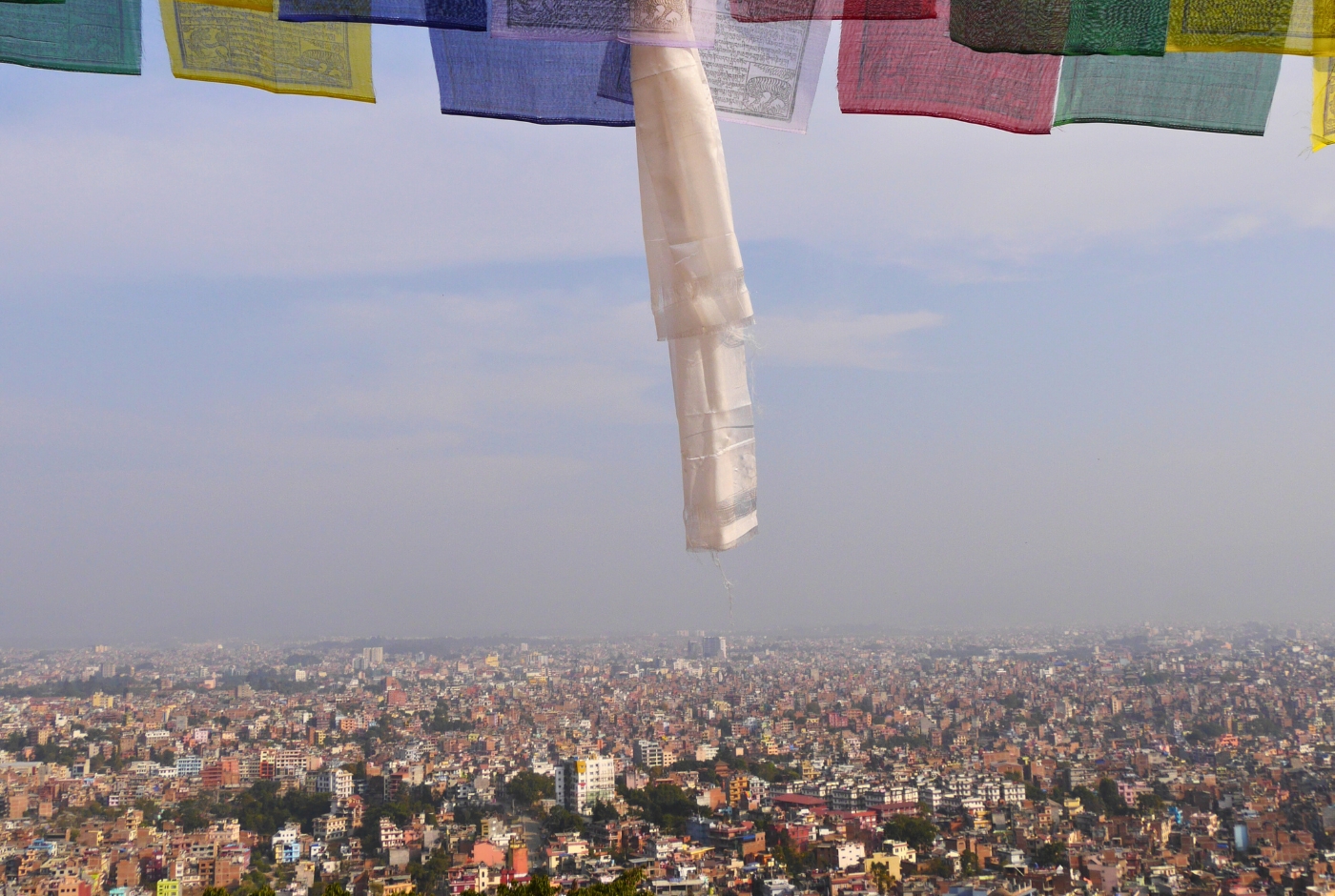
Kathmandu Temperature in all Seasons
Kathmandu has a subtropical highland climate with four distinct seasons: spring (March-May), monsoon/summer (June-August), autumn (September-November), and winter (December-February). Winter is mild with dry weather, summer is warm and humid, and monsoon brings heavy rainfall. The best time to visit is during spring or autumn when the weather is pleasant and clear.
Spring (March-May): Temperatures gradually increase during spring, with March being relatively cold and May being warm. Expect occasional light rain or short bursts of rain, as the monsoon season is approaching.
Monsoon/Summer (June-August): June to August is Kathmandu's monsoon season, characterized by heavy rainfall and high humidity. Temperatures can be very warm, ranging from 67°F to 81°F (19°C to 27°C).
Autumn (September-November): September marks the end of the monsoon and a transition to a cooler, drier period. November is quite cold and dry, with temperatures starting to drop.
Winter (December-February): Winters in Kathmandu are mild and dry, with temperatures typically ranging from 36°F to 68°F (2°C to 20°C). Mornings and evenings can be chilly.
How does the author describe kathmandu busiest streets?
The author vividly portrays Kathmandu's busiest streets as a chaotic yet vibrant mix of the religious and the commercial. They describe narrow streets lined with small shrines, colorful deities, and a diverse array of vendors and shops. The streets are filled with a cacophony of sounds, including music, honking vehicles, and vendors shouting their wares, creating a lively and sensory-rich atmosphere. Here's a more detailed look at how the author describes Kathmandu's busiest streets:
- Vibrant and Lively: The author emphasizes the bustling and energetic nature of the streets, highlighting the constant flow of people and activity.
- Narrow and Busy: The streets are described as narrow, creating a sense of intimacy and a crowded feel.
- Religious and Commercial: The author notes the presence of small shrines and religious figures alongside shops and vendors, reflecting the blend of religious and commercial life in Kathmandu.
- Diverse Vendors and Shops: The streets are home to various vendors selling fruits, flutes, postcards, Western cosmetics, film rolls, and other goods.
- A Sensory Overload: The author captures the sensory experience of the streets, mentioning the sounds of music, traffic, and vendors, as well as the aroma of spices and street food.
- Flower-Adorned Deities: The author highlights the presence of small shrines and deities adorned with flowers, adding to the spiritual aspect of the streets.
- Stray Cows: The author also mentions stray cows roaming the streets, a unique and somewhat comical aspect of Kathmandu's urban landscape.
How to see Mount Everest from kathmandu?
To see Mount Everest from Kathmandu, consider a scenic flight, a helicopter tour, or a trek to a viewpoint. Scenic flights offer aerial views of the Himalayas, while helicopter tours can take you closer to Everest Base Camp or viewpoints like Kala Patthar. Treks to viewpoints like Nagarkot, Chandragiri Hill, or Dhulikhel can also provide panoramic views.
Final Words
Kathmandu has suitable weather for sightseeing tours all year round. One should visit Kathmandu once and taste its timeless arts, culture, history, and architecture. Its excellent world heritage sites are must-see destinations sites in Nepal. One will indeed have a splendid time exploring the epicenter of the Himalayan kingdom.


